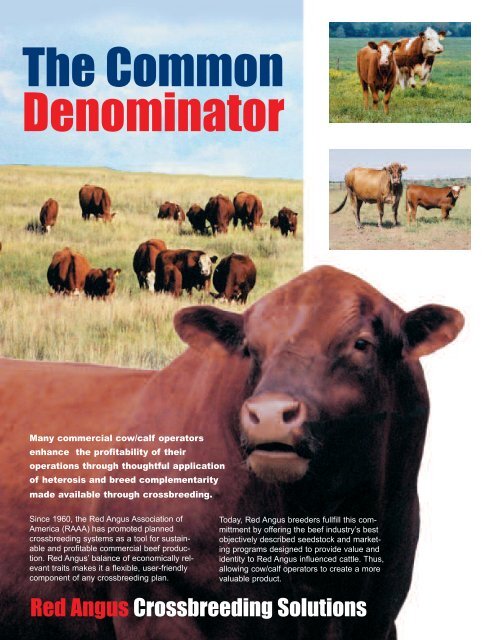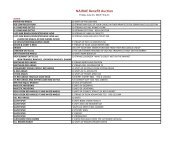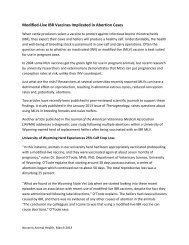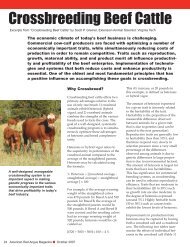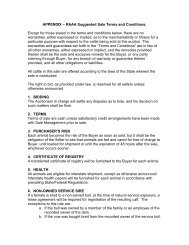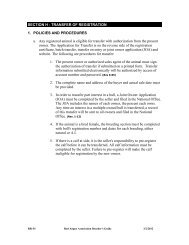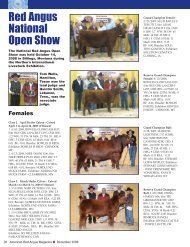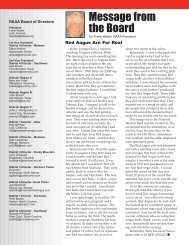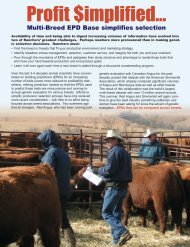The Common Denominator - Red Angus Association of America
The Common Denominator - Red Angus Association of America
The Common Denominator - Red Angus Association of America
Create successful ePaper yourself
Turn your PDF publications into a flip-book with our unique Google optimized e-Paper software.
<strong>The</strong> <strong>Common</strong><br />
<strong>Denominator</strong><br />
Many commercial cow/calf operators<br />
enhance the pr<strong>of</strong>itability <strong>of</strong> their<br />
operations through thoughtful application<br />
<strong>of</strong> heterosis and breed complementarity<br />
made available through crossbreeding.<br />
Since 1960, the <strong>Red</strong> <strong>Angus</strong> <strong>Association</strong> <strong>of</strong><br />
<strong>America</strong> (RAAA) has promoted planned<br />
crossbreeding systems as a tool for sustainable<br />
and pr<strong>of</strong>itable commercial beef production.<br />
<strong>Red</strong> <strong>Angus</strong>’ balance <strong>of</strong> economically relevant<br />
traits makes it a flexible, user-friendly<br />
component <strong>of</strong> any crossbreeding plan.<br />
Today, <strong>Red</strong> <strong>Angus</strong> breeders fullfill this committment<br />
by <strong>of</strong>fering the beef industry’s best<br />
objectively described seedstock and marketing<br />
programs designed to provide value and<br />
identity to <strong>Red</strong> <strong>Angus</strong> influenced cattle. Thus,<br />
allowing cow/calf operators to create a more<br />
valuable product.<br />
<strong>Red</strong> <strong>Angus</strong> Crossbreeding Solutions
Crossbreeding Tools<br />
Genetic Change =<br />
Heritability x Selection Pressure<br />
Heritability is the proportion <strong>of</strong> an animal’s genetic merit that<br />
is - on average - transmitted to their <strong>of</strong>fspring. Heritability varies<br />
for different traits, (seeTable 1 – opposite page). Reproductive<br />
traits tend to have low heritabilities, while growth traits are moderate<br />
and carcass characteristics typically have higher heritabilities.<br />
Selection pressure utilizes genetic variation. In practice most<br />
selection pressure involves utilizing bulls whose genetic merit<br />
(for those traits the producer seeks to improve) is superior to the<br />
average <strong>of</strong> the cows they will breed. In Crossbreeding, genetic<br />
variation comes from both the selected variation within a breed<br />
(represented by EPDs), and the genetic variation between<br />
selected breeds (breed differences). When selection pressure is<br />
applied across breeds to allow one breed’s strength to <strong>of</strong>fset<br />
another’s weakness, these breed differences are referred to as<br />
Breed Complementarity.<br />
Breed Complementarity...<br />
...occurs from combining the desirable<br />
characteristics <strong>of</strong> two or more breeds to<br />
achieve a higher frequency <strong>of</strong> desired<br />
genes among the crossbreds than could be<br />
found within a single breed.<br />
In other words, the strong points <strong>of</strong> one or more breeds can be<br />
used to compensate for the weaknesses <strong>of</strong> another breed.<br />
Thus, benefits gained through taking advantage <strong>of</strong> breed differences<br />
are due to “additive” gene effects. Different breeds excel<br />
in different traits. British breeds are traditionally categorized as<br />
maternal, efficient cattle that produce high quality carcasses,<br />
Continental cattle are known for producing lean carcasses with<br />
high red meat yield, and Zebu breeds can <strong>of</strong>fer heat tolerance<br />
and increased insect resistance.<br />
Large breed differences exist in traits such as:<br />
Growth Rate Carcass Composition Age at Puberty<br />
Mature Size Calving Difficulty Milk Production<br />
<strong>The</strong> “ideal cow herd” and breeding program varies depending on<br />
the area in which your operation is located, your product, and<br />
your target market. Once you have analyzed these aspects <strong>of</strong><br />
your operation you can design and implement a breeding program<br />
that will help you achieve your production goals.
Heterosis (hybrid vigor) results from<br />
“nonadditive” gene effects. Heterosis is<br />
defined as the percent <strong>of</strong> superiority<br />
expressed in a trait by crossbred progeny<br />
over the average <strong>of</strong> the parents’ breeds in<br />
the cross.<br />
Heterosis is calculated by the following formula:<br />
Crossbred Avg. - Straightbred Avg.<br />
Straightbred Avg.<br />
x 100 = % Heterosis<br />
i.e. assume that the two parent breeds in a<br />
cross had weaning weight averages <strong>of</strong> 575 and<br />
475 lb. And their crossbred progeny averaged<br />
550 lb. <strong>The</strong> percent <strong>of</strong> heterosis would be:<br />
550 - 525<br />
525<br />
x 100 = 4.8%<br />
Heterosis and Heritability<br />
<strong>The</strong> degree <strong>of</strong> heterosis varies between traits, and<br />
follows a general rule that it tends to be inversely<br />
proportional to that trait’s heritability. In moderate to<br />
highly heritable traits, such as carcass composition,<br />
the level <strong>of</strong> heterosis is low, while traits <strong>of</strong> low heritability<br />
such as calving rate and weaning rate have<br />
higher levels <strong>of</strong> heterosis. Table 1 shows that heterosis<br />
obtained through crossbreeding is a powerful<br />
tool for increasing performance in traits with low heritabilities.<br />
This polled and pigmented <strong>Red</strong> <strong>Angus</strong> sired calf<br />
out <strong>of</strong> a dehorned Hereford cow is an example <strong>of</strong><br />
individual heterosis.<br />
Table 1. Heritability and Heterosis Estimates for<br />
Some Economically Important Traits.<br />
Trait Heritability a Total<br />
heterosis b<br />
(%)<br />
Calving rate .02 - .17 6<br />
Calf survival to weaning .10 - .15 4<br />
Weaning rate .17 8<br />
Birth weight direct .31 6<br />
Weaning weight direct .24 11<br />
Milk production .20 9<br />
Post-weaning gain .31 3<br />
Yearling weight .33 4<br />
Mature cow weight .50 1<br />
Feed conversion (TDN/gain) .32 - 2<br />
Dressing % .39 0<br />
Rib eye area .42 2<br />
% cutability/retail product .47 0<br />
Marbling/quality grade .38 2<br />
Tenderness .29 0<br />
Heterosis...<br />
Individual vs. Maternal Heterosis<br />
Individual heterosis is the increased performance a crossbred calf exhibits<br />
relative to its straightbred parents for traits such as growth to weaning, or<br />
yearling weight.<br />
Maternal heterosis is expressed in the crossbred female’s progeny, such as<br />
the increased weaning weight <strong>of</strong> crossbred females’ calves due to the<br />
increased milk production <strong>of</strong> their crossbred dams.<br />
Heterosis increases lifetime production per cow 20-25% in Bos taurus x Bos<br />
taurus crosses. This increase results from the cumulative effects <strong>of</strong> heterosis<br />
which include: increased fertility, longevity, weaning rate, etc.<br />
<strong>The</strong> table below compares increases in weight <strong>of</strong> calf weaned per cow<br />
exposed that may be expected with individual heterosis vs. both individual<br />
and maternal heterosis.<br />
Straightbred Cows<br />
& Straightbred Calves<br />
Straightbred Cows<br />
& Crossbred Calves<br />
Crossbred Cows<br />
& Crossbred Calves<br />
a Koots et al. (1994).<br />
b Kress and Nelsen (1998).
Crossbreeding Systems<br />
Utilizing crossbreeding systems to meet production goals requires using breeds<br />
that complement each other while maintaining optimum levels <strong>of</strong> heterosis.<br />
Additionally, the system must fit the size <strong>of</strong> the<br />
producer: herd size, number <strong>of</strong> pastures, and other<br />
practical constraints. Below several crossbreeding<br />
schemes are evaluated; each <strong>of</strong>fers different<br />
opportunities and requires varying levels <strong>of</strong> inputs<br />
and management.<br />
Rotational System<br />
<strong>Red</strong> <strong>Angus</strong> are especially well suited for Rotational<br />
systems due to their calving ease, maternal merit, moderate<br />
size, growth and carcass quality. This balance <strong>of</strong><br />
traits make <strong>Red</strong> <strong>Angus</strong> a natural fit for crossbreeding<br />
systems that generate replacement females with very<br />
acceptable levels <strong>of</strong> maternal heterosis.<br />
Note: To avoid large swings in biological type, choose breeds that are<br />
genetically similar for birth weight, mature size and milk production.<br />
Two-Breed Rotation<br />
Cows sired by Breed A (<strong>Red</strong> <strong>Angus</strong>) bred to Breed B bull (Hereford,<br />
Simmental, etc.). Resulting daughters bred back to Breed A for the<br />
rest <strong>of</strong> their lives. Daughters resulting from this cross are bred back<br />
to bull from Breed B. A female is always bred to a bull <strong>of</strong> a different<br />
breed than her sire. (Diagram 1)<br />
Sire selection objectives: Choose sires similar for calving ease,<br />
maternal traits, and mature size. Must ID sires to daughters.<br />
No. <strong>of</strong> Sires: 2<br />
No. <strong>of</strong> Pastures: 2<br />
Min. No. <strong>of</strong> Cows: 50<br />
% Heterosis: 67%<br />
Expected increase in lbs <strong>of</strong><br />
calf per cow exposed = 16%<br />
Diagram 1<br />
Females bred to<br />
bulls <strong>of</strong> Breed A<br />
Example: <strong>Red</strong> <strong>Angus</strong> bulls<br />
Replacements<br />
Breeding Group1 Breeding Group 2<br />
Replacements<br />
Females bred to<br />
bulls <strong>of</strong> Breed B<br />
Example: Hereford bulls<br />
Three-Breed Rotation Diagram 2<br />
Cows sired by Breed A (<strong>Red</strong> <strong>Angus</strong>) bred to Breed B bull. Resulting<br />
daughters bred back to Breed C for the rest <strong>of</strong> their lives. Daughters<br />
resulting from this cross are bred back to bull from Breed A. A female<br />
is always bred to the sire she is least related to. (Diagram 2)<br />
Sire selection objectives: Choose sires similar for calving ease,<br />
maternal traits, and mature size. Must ID sires to daughters.<br />
No. <strong>of</strong> Sires: 3<br />
No. <strong>of</strong> Pastures: 3<br />
Min. No. <strong>of</strong> Cows: 75<br />
% Heterosis: 86%<br />
Expected increase in lbs <strong>of</strong><br />
calf per cow exposed = 20%<br />
Females bred to<br />
bulls <strong>of</strong> Breed A<br />
Example: <strong>Red</strong> <strong>Angus</strong> bulls<br />
Replacements<br />
Replacements<br />
Breeding Group1 Breeding Group 2<br />
Breeding Group 3<br />
Females bred to<br />
bulls <strong>of</strong> Breed B<br />
Example: Hereford bulls<br />
Replacements<br />
Females bred to<br />
bulls <strong>of</strong> Breed C<br />
Example: Simmental bulls<br />
This symbol denotes Crossbreeding opportunities that<br />
work equally well for both small and large producers.
Terminal System<br />
In this system cows <strong>of</strong> a specific two-breed cross are mated to a “terminal”<br />
sire <strong>of</strong> a third breed, and all resulting progeny are marketed.<br />
This system allows the producer to make cows from maternal breeds<br />
which fit a specific production environment. <strong>The</strong> Terminal sire can be<br />
chosen based on other traits such as growth, rib eye area, etc. With<br />
advanced genetic selection tools for reproduction and maintenance,<br />
<strong>Red</strong> <strong>Angus</strong> is an obvious choice for one maternal component <strong>of</strong> this<br />
crossbreeding system.<br />
This is the simplest, fastest and most effective way <strong>of</strong> utilizng the advantages <strong>of</strong><br />
crossbreeding - heterosis and breed complementarity. Producers purchase F1 (two breed cross)<br />
replacement females, mate them to a terminal breed <strong>of</strong> bull and market all <strong>of</strong> the progeny. No heifer<br />
calves are retained as replacements.<br />
Selection objectives:<br />
1. Select <strong>Red</strong> <strong>Angus</strong> influenced ProCow Replacement Females for fertility, fleshing ability and<br />
environmental fit.<br />
2. Select <strong>Red</strong> <strong>Angus</strong> or F1 <strong>Red</strong> <strong>Angus</strong> Hybrid sires to target quality pricing grids.<br />
OR<br />
3. Select terminal sires or <strong>Red</strong> <strong>Angus</strong> x terminal F1 Hybrid sires to increase growth and red meat yield.<br />
No. <strong>of</strong> Sires: 1<br />
Expected increase in lbs <strong>of</strong><br />
No. <strong>of</strong> Pastures: 1<br />
calf per cows exposed = 25%<br />
Min. No. <strong>of</strong> Cows: any size<br />
% Heterosis: This system maximizes use <strong>of</strong> individual and maternal heterosis<br />
Terminal Sire<br />
Purchase F1 Females<br />
Example:<br />
Purchased<br />
ProCow<br />
Replacement<br />
Females bred to<br />
Continental or<br />
Hybrid bulls<br />
<strong>Red</strong> <strong>Angus</strong> Replacements<br />
for Pr<strong>of</strong>essional Cattlemen<br />
Maternal Efficiency means much more than maximum milk production. <strong>The</strong> cumulative<br />
effect <strong>of</strong> reproduction, calving ease, optimal milk flow, fleshing and foraging ability, longevity,<br />
and low maintenance costs make <strong>Red</strong> <strong>Angus</strong> an obvious cornerstone <strong>of</strong> any cow/calf<br />
operation. ProCows must be a minimum <strong>of</strong> 3/8th <strong>Red</strong> <strong>Angus</strong>. Interested in buying or selling<br />
Procows? Find or list them at www.redangus.org<br />
Artificial Insemination (A.I.) is a management tool that allows producers to utilize<br />
heterosis and breed complementarity in a simple and effective way. A.I. enhances selection precision<br />
by allowing producers access to high accuracy, proven sires. New synchronization programs make<br />
A.I. more manageable and cost effective. Here are some management practices that can eliminate<br />
the need for buying pasture bulls <strong>of</strong> multiple breeds.<br />
• A.I. heifers to high Calving Ease (CED EPD) <strong>Red</strong> <strong>Angus</strong> bulls<br />
• A.I. mature British breed herds to high growth, high cutability terminal sires to increase pounds and lean yield.<br />
• A.I. mature <strong>Angus</strong> herds to high maternal continentals or hybrids to produce replacements<br />
• A.I. mature Continental or Brahman influenced herds to <strong>Red</strong> <strong>Angus</strong> bulls to reduce feed requirements and enhance carcass quality.<br />
• Utlize <strong>Red</strong> <strong>Angus</strong> bulls in “Clean Up” roles behind an A.I. program - even when using a terminal A.I. sire. Calves sired by a <strong>Red</strong><br />
<strong>Angus</strong> pasture bull will make outstanding replacements.<br />
Hybrid Bulls are F1 cross (50% Breed A + 50% Breed B) and <strong>of</strong>fer the<br />
advantages <strong>of</strong> combining heterosis and breed complementarity in one package.<br />
<strong>Red</strong> <strong>Angus</strong> may be paired with a terminal continental, maternal continental, British,<br />
or Bos indicus breed to build <strong>Red</strong> <strong>Angus</strong> influenced hybrids. However, they are<br />
<strong>of</strong>ten used to infuse continental breeds without getting a full 50% continental in the<br />
resultant calves. Using unrelated F1 bulls <strong>of</strong> the same breed (A-B, A-B) can result<br />
in a retention <strong>of</strong> 50% <strong>of</strong> maximum possible heterosis. Rotating F1 bulls<br />
that have one breed in common (A-B, A-C) can result in 67% heterosis.<br />
Rotating F1 bulls that have no breeds in common (A-B, C-D) can <strong>of</strong>fer<br />
83% <strong>of</strong> maximum heterosis.
<strong>The</strong> Crossbreeding Specialist<br />
Crossbreeding does not replace the need for high quality purebred cattle. In fact, accurately<br />
described seedstock resources are paramount to the success <strong>of</strong> a crossbreeding program.<br />
Industry’s most reliable genetic predictions<br />
<strong>Red</strong> <strong>Angus</strong> led the beef industry by implementing Total<br />
Herd Reporting (THR) in 1995 as a means <strong>of</strong> providing the<br />
most reliable EPDs. THR requires the annual production <strong>of</strong> every cow<br />
and the performance information <strong>of</strong> every calf raised through weaning to be<br />
reported. THR eliminates selection bias, which can skew genetic predictions<br />
when only data from the calves “good enough to register” is reported.<br />
<strong>The</strong> number <strong>of</strong> EPDs calculated by beef breeds continues to grow. <strong>Red</strong> <strong>Angus</strong><br />
continues to describe reproduction, growth, maintenance, and carcass using the<br />
fewest EPDs possible. Achieving this goal has meant that <strong>Red</strong> <strong>Angus</strong> focuses<br />
less on indicator traits and more on the Economically Relevant Traits (ERTs) that<br />
affect their bull customers’ bottom lines. <strong>Red</strong> <strong>Angus</strong>’ use <strong>of</strong> THR and ERTs make<br />
it the ideal British component for any crossbreeding system.<br />
Pr<strong>of</strong>it starts at Reproduction! Research has shown reproduction to have<br />
four to ten times the economic impact <strong>of</strong> carcass traits. <strong>Red</strong> <strong>Angus</strong>’ unique utilization <strong>of</strong> THR<br />
allows the breeding and subsequent pregnancy/calving <strong>of</strong> each replacement heifer to be<br />
reported. In a nutsell, <strong>Red</strong> <strong>Angus</strong> is the only major beef breed to completely describe cow<br />
herd reproduction from unassisted birth to productive lifespan.<br />
Cows Eat Money! In January, 2004, <strong>Red</strong> <strong>Angus</strong> published the Mature Cow<br />
Maintenance Energy Requirement (ME) EPD becoming the first breed to evaluate the<br />
expense side <strong>of</strong> the rancher’s pr<strong>of</strong>it equation. Expressed in Mega-calories per month, differences<br />
in ME EPD can easily translate into differences in feed required to maintain body<br />
weight. Use ME in conjunction with revenue traits to ensure the income from increased performance<br />
isn’t “eaten up” by increased feed costs.<br />
ANGUS<br />
Genetic Predictions <strong>of</strong> the Future - Across Breed EPDs!<br />
<strong>Red</strong> <strong>Angus</strong> is one <strong>of</strong> several breeds who seek to serve commercial customers better by providing<br />
true across breed (Multi-breed) EPDs. <strong>The</strong>se genetic predictions will allow commercial<br />
customers to make better informed crossbreeding decisions because all breeds’ EPDs<br />
would evaluate the same traits, be calculated using the same models and presented on<br />
equivalent PLUS<br />
base and scale. This will allow producers to evaluate animals across breeds as<br />
well as hybrids<br />
Enough<br />
and<br />
Ear,<br />
composites<br />
But Not Too<br />
on a<br />
Much.<br />
level playing field, as the multi breed model will account<br />
for performance due to heterosis that is seen in derivative cattle. Working with other breeds<br />
and the National Beef Cattle Evaluation Consortium, these genetic predictions <strong>of</strong> the future<br />
are just around the corner.<br />
Enough Ear, But Not Too Much.<br />
• <strong>Angus</strong> x Brahman derivatives<br />
• Registered with the RAAA<br />
• <strong>Red</strong> or Black in hide color<br />
• Flexible <strong>Angus</strong> Percentage<br />
from 65% to 96%<br />
<strong>Angus</strong> Plus <strong>of</strong>fers producers flexibility to breed cattle that are<br />
best suited for their customers’ ranch environments.<br />
With “Enough Ear, But Not Too Much”, <strong>Angus</strong> Plus allows breeders to take<br />
advantage <strong>of</strong> the breed complementarity existing between <strong>Angus</strong> and<br />
Brahman cattle as well as the heterosis that is expressed in a Bos taurus x<br />
Bos indicus cross.
<strong>The</strong> <strong>Red</strong> <strong>Angus</strong> Formula<br />
<strong>Red</strong> <strong>Angus</strong> x Termininal Continentals<br />
<strong>Red</strong> <strong>Angus</strong> crossed with terminal Continental breeds like Charolais and<br />
Limousin, produce feedlot cattle that can excel in feedlot efficiency while<br />
reaping premiums for both Yield and Quality grade. While these<br />
Continentals are known to improve Yield Grade through increased<br />
leaness and ribeye area, <strong>Red</strong> <strong>Angus</strong> complements both with improved<br />
marbling and fewer days to finish. <strong>The</strong> feedlot industry values the intangible<br />
traits <strong>of</strong> <strong>Red</strong> <strong>Angus</strong> crosses, such as improved docility; fewer bruises<br />
when handling and ease <strong>of</strong> starting on feed.<br />
<strong>Red</strong> <strong>Angus</strong> x Maternal Continentals<br />
When crossed with maternal Continental breeds such as Simmental and<br />
Gelbvieh, <strong>Red</strong> <strong>Angus</strong> can improve production efficiency. Through breed<br />
complementarity, <strong>Red</strong> <strong>Angus</strong> can lower birthweights, moderate mature<br />
size, decrease cow maintenance requirements, extend longevity and<br />
thus, improve the overall functionality <strong>of</strong> the replacement females resulting<br />
from such crosses.<br />
<strong>Red</strong> <strong>Angus</strong> x British Breeds<br />
<strong>The</strong> “Baldy” female is still a favorite for many commercial ranch environments,<br />
and are produced in uniform fashion when <strong>Red</strong> <strong>Angus</strong> and<br />
Hereford are crossed. Added maternal traits and marbling genetics are<br />
produced in the polled, pigmented progeny <strong>of</strong> this British x British cross.<br />
<strong>The</strong> <strong>Red</strong> <strong>Angus</strong> component <strong>of</strong> highly efficient baldy steers helps them<br />
reach choice grade faster. <strong>Red</strong> <strong>Angus</strong> can be used on other British<br />
breeds to reduce maintenance costs and add fleshing ability.<br />
<strong>Red</strong> <strong>Angus</strong> x Brahman Derivatives<br />
In regions that require added heat tolerance, <strong>Red</strong> <strong>Angus</strong> and <strong>Angus</strong> Plus<br />
bulls work well on Brahman derivatives or other heat tolerant Bos taurus<br />
breeds, such as Senepol. <strong>The</strong> replacements resulting from such crosses<br />
make adaptable, heat tolerant, easy fleshing brood cows, while their<br />
steer mates should express improved carcass traits due to <strong>Red</strong> <strong>Angus</strong>’<br />
superior marbling genetics. Additionally, higher levels <strong>of</strong> heterosis may<br />
be seen when <strong>Red</strong> <strong>Angus</strong> are used on cattle <strong>of</strong> such divergent origins.<br />
Various biotypes <strong>of</strong> cattle ranked by cost <strong>of</strong> gain.<br />
Feed b<br />
Cost <strong>of</strong> gain b<br />
Biotype % Choice a %YG 1 & 2 a Conversion /cwt c<br />
1/4 Continental 3/4 British 66 52 6.52 $54.00<br />
1/2 Continental 1/2 British 56 56 6.49 $54.80<br />
100% British 70 38 6.76 $57.50<br />
100% Continental 30 89 6.78 $59.80<br />
3/4 Continental 1/4 British 43 83 6.72 $60.10<br />
a<br />
Adapted from U.S. MARC data (Cundiff, 1999).<br />
b Swift & Co. and Gelbvieh Alliance data (T. Schiefelbein, 2003 and D. Schiefelbein, 1998).<br />
c Includes interest.
Crossbreeding Pays<br />
With inherent maternal efficiencies, unsurpassed carcass merit,<br />
and objective genetic predictions, <strong>Red</strong> <strong>Angus</strong> is a logical “<strong>Angus</strong>”<br />
foundation for any crossbreeding system. Across different environments,<br />
marketing goals, and breeding systems, the inclusion <strong>of</strong> <strong>Red</strong> <strong>Angus</strong> with its focused<br />
selection for economically relevant traits provides an excellent means to access the<br />
economic benefits <strong>of</strong> breed complementarity and heterosis. In addition, <strong>Red</strong> <strong>Angus</strong><br />
<strong>of</strong>fers numerous marketing programs to assist bull customers in harvesting the full<br />
value <strong>of</strong> their investment in superior <strong>Red</strong> <strong>Angus</strong> genetics.<br />
Herd Size - Systematic crossbreeding programs are more easily<br />
carried out in larger herds. However, the use <strong>of</strong> F1 bulls,<br />
PRO-COW replacement females and/or extensive A.I. provide<br />
simple crossbreeding solutions when herd size falls beneath 50<br />
cows.<br />
Identifying Value...<strong>The</strong> <strong>Red</strong> <strong>Angus</strong> Feeder<br />
Calf Certification Program (FCCP) provides market<br />
topping results when <strong>Red</strong> <strong>Angus</strong> bulls are<br />
used on a variety <strong>of</strong> beef breed females. This<br />
USDA Process Verified Program identifies <strong>Red</strong><br />
<strong>Angus</strong> sired calves with the yellow FCCP tag for<br />
traceability to <strong>Angus</strong> Genetics, Source<br />
Verification to ranch <strong>of</strong> origin and Group Age verification.<br />
In addition to the demand created by<br />
Certified <strong>Red</strong> <strong>Angus</strong> calves’ access to <strong>Angus</strong><br />
product lines, these calves can fit various programs<br />
<strong>of</strong>fering premiums for source and age verified<br />
cattle.<br />
Certified <strong>Red</strong> <strong>Angus</strong> are supported with<br />
FREE marketing tools that expand market<br />
access for both feeder and fed cattle.<br />
Regardless <strong>of</strong> the breed type <strong>of</strong> a producer’s<br />
base cow herd, <strong>Red</strong> <strong>Angus</strong> bulls and the “yellow”<br />
FCCP tag are the ticket to higher calf prices and<br />
additional fed cattle marketing options.<br />
Crossbreeding isn’t for Everyone<br />
“R” Stamped - Certified <strong>Red</strong> <strong>Angus</strong><br />
Carcasses on their way to branded<br />
product premiums<br />
Fitting Production Environment - More is not always better.<br />
Care must be taken to build crossbred replacement females<br />
which fit the environment they must work in. More size, more<br />
frame, more growth, or more milk may result in reduced reproductive<br />
efficiency, increased feed costs, and reduced pr<strong>of</strong>its.<br />
Pastures and Herd Bulls - Unless maximum use is made <strong>of</strong><br />
A.I. or replacements are purchased, crossbreeding usually<br />
means keeping two or more breeds <strong>of</strong> bulls and providing more<br />
than one breeding pasture during the breeding season.<br />
Consequently, producers incur greater investments in bulls and<br />
the infrastructure required to seperate breeding pastures.<br />
Identification and Record Keeping - Crossbreeding<br />
requires accurate identification <strong>of</strong> the genetic makeup <strong>of</strong> each<br />
generation.<br />
Matching Biological Types - Breeds differ in bio-economic<br />
traits; this is one reason for crossbreeding. However, extreme<br />
mis-matches in biological type can lead to problems.<br />
• Calving difficulty when a large breed <strong>of</strong> sire is mated to a small<br />
breed <strong>of</strong> cow.<br />
• Failure to efficiently utilize a large crossbred cow when she is<br />
rotationally mated to a smaller breed <strong>of</strong> sire.<br />
• Large swings in biological type from generation to generation<br />
in some rotational systems.<br />
Fit the Box - Only introduce breeds into your crossbreeding<br />
scheme that complement your marketing plan. Adding high retail<br />
yield breeds won’t improve performance on a quality based grid.<br />
Adding high growth, large framed breeds generally will not work<br />
for producers who background and sell yearlings. Using high<br />
maintenance, low maternal sires may limit the value <strong>of</strong> replacement<br />
females.<br />
Sustaining a Crossbreeding System Requires<br />
Discipline - Because <strong>of</strong> the length <strong>of</strong> generation interval <strong>of</strong> beef<br />
cattle, crossbreeding programs are not an overnight fix.<br />
Successful crossbreeding programs have plans for optimizing heterosis,<br />
while making the necessary improvement in additive<br />
genetic traits as required by their environment, management and<br />
marketing programs.<br />
Building Better Beef...<br />
<strong>Red</strong> <strong>Angus</strong><br />
(940) 387-3502 • www.<strong>Red</strong><strong>Angus</strong>.org


